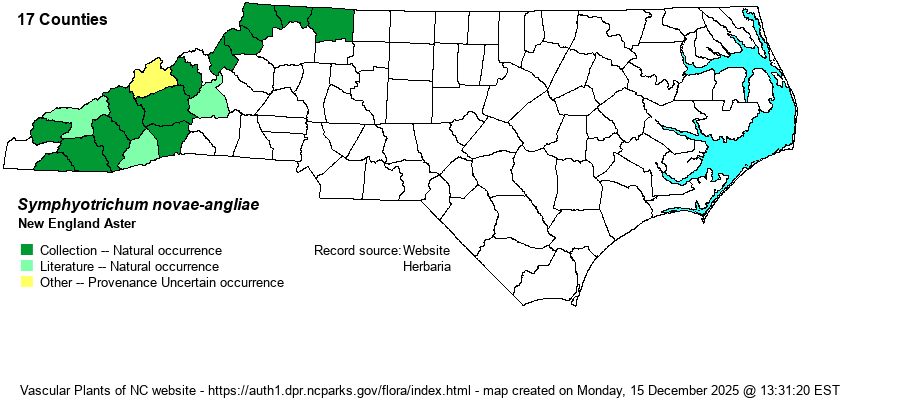| Author | (L.) G.L. Nesom | |
| Distribution | Mountains only. Long in the horticultural trade, some NC records are certainly not natural occurrences -- more likely to be escaped or naturalized.
N.S. to ND, south to northern GA, central MS, AR, OK, NM. Introduced and escaping farther west. | |
| Abundance | Clearly declining; formerly probably uncommon to locally fairly common, but now rare to locally uncommon in the northern counties, and quite rare in the southern Mountains. This is no longer an S3 species, and S2S3 or even S2 is better today. It is, deservedly, a Watch List species, as there are very few recent collections. It may need to be listed as Significantly Rare in upcoming years, owing to habitat loss. | |
| Habitat | Marshes, wet meadows, montane seepage bogs, ditches, and other mostly sunny but damp ground. Has lost considerable habitat in recent decades owing to wetland drainage and other impacts. |
| Phenology | Flowering and fruiting September-October. | |
| Identification | Arguably the most beautiful of our asters, the robust stems grow several together, to 6 feet tall, the stems spreading-hairy in the upper half. Leaves are numerous, lance-shape to elliptic, up to 3.5 inches long, margins entire, the surfaces rough. The inflorescence is rather flat-topped to rounded, with broad heads and long rosy-purple to purple (a strong red tint as opposed to a blue tint to the rays) and yellow disks. Purplestem Aster (S. puniceum) is similar, but its leaf margins are toothed and the involucral bracts lack stalked glands; it has mostly bluish ray flowers. If you are driving and spot a colony of these plants in bloom, you will certainly stop and take some photographs! | |
| Taxonomic Comments | NOTE: The genus Aster was examined by G.L. Nesom (1994), who determined that it was composed of a number of discrete genera (a few of which were already split off by authors as Sericocarpus, Ionactis, etc.). The earliest available name for North American "Aster" is Symphyotrichum, a name regrettably long and hard to spell.
New England Aster has long been in the horticultural trade, and most people are likely familiar with it only in yards and gardens.
| |
| Other Common Name(s) | None | |
| State Rank | S3 [S2S3] | |
| Global Rank | G5 | |
| State Status | W1 | |
| US Status | | |
| USACE-agcp | FACW link |
| USACE-emp | FACW link |

